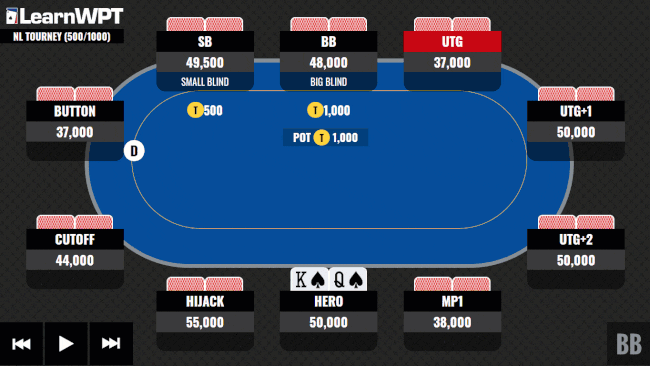Flopped the Nuts with K♠Q♠, what do you do here?
DECISION POINT: You are the middle stages of a Tournament with blinds at 500/1,000 with a 1,000 big blind ante. It folds to you in Middle Position and you raise to 2,500 with K♠Q♠. Action folds to the Big Blind who 3-Bets to 10,000 and you call. The flop comes T♠A♣J♠ and Villain checks. Action is on you, what do you do here?
PRO ANSWER: We are in the middle stages of a multi-table tournament with a big blind ante in play. It folds to us in MP2 with KsQs and we open to 2,500 (2.5BBs). All other players fold to the Big Blind who makes it 10,000 (10BBs).
This is a spot where the Big Blind should be 3-betting quite wide given the amount of pressure it puts on a 50BB stack (a GTO 3-betting range from the Big Blind even includes some combinations of 53s/64s). Against players in the Big Blind who are only 3-betting very narrow range we could make an exploitative fold here preflop, but against reasonable players this is a hand we must defend with. We do elect to call and it’s off to the flop.
The flop is TsAcJs and we flopped the nuts with a flush redraw. Surprisingly our opponent checks. When Villain 3-bets us and then checks on this flop their range is extremely polarized, meaning they either have extremely strong hands here or extremely weak ones.
Continued below...
We block hands like KK/QQ here, although those hands do make some sense as part of a checking range for our opponent. We also block AK/AQ, although they would likely bet the flop with those combinations on the flop. This means a lot of our opponent's range is composed of AA/JJ/TT/AJ/AT type hands with some complete air like the aforementioned 53s/64s. In spots such as this one where the stack to pot ratio (SPR) is so low and our opponent’s range is quite polarized, it makes a lot of sense to slowplay.
If our opponent has a hand as strong as JJ we are likely to get the rest of the chips in the middle regardless if we decide to bet or check here. If they have the weaker part of their range and a hand like 64s and we check here we will sometimes induce bluffs on future streets from a hand that would have folded to aggression.
Betting out for protection isn’t as valuable as it might be in other circumstances since we hold 2 spades. Given how our hand interacts with the board and how polarized our opponent’s range is in this spot, it is a great spot to slowplay.
Checking is the best play.
How would you play it?
Share your answer in the comments below!
Improve Your Game Today!
Join LearnWPT and Get:
Think Like a Pro
- The WPT GTO Trainer to play real solved hands and get instant feedback on YOUR leaks
- On-demand access to in-depth Strategy Episodes
- All of your poker questions answered with the Ask a Pro Feature
- Expert analysis from LearnWPT Pros using The Hand Input Tool
- Community Forums to discuss all things poker with fellow LearnWPT Members
- Downloadable Tools you can use at and away from the tables
To join (just $5 your 1st month) click the JOIN NOW button at the top of your screen or the button below and start improving your game!
Have Questions about LearnWPT? Email us at [email protected] and we’ll be happy to help!


